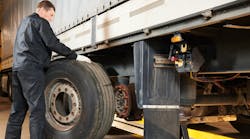The American Transportation Research Institute (ATRI) shared the results of its annual Top Industry Issues survey, with the driver shortage, hours of service, and driver compensation topping this year's list.
Rebecca Brewster, president and CEO for the ATRI Board of Directors, moderated a panel titled "The Big Reveal" during the American Trucking Associations' (ATA) Management Conference & Exhibition (MCE) this week to get perspective from representatives in different areas of the industry. Gary Helms, America's Road Team captain and driver for Covenant Transport; and James Reed, president and CEO of USA Trucks; provided driver and carrier insights, respectively. Additionally, ATA's Senior Vice President and Chief Economist Bob Costello shared his opinions on the impact of the issues below.
Top 10 issues
#10 Economy. For the second year in a row, the economy held a spot in the Top Industry Issues survey. Compared to 2018, the 2019 freight market has softened, along with the continued concerns of a trade war with China and potential changes to the United States-Mexico-Canada Agreement (USMCA) designed to replace the North American Free Trade Agreement (NAFTA), and concerns with pending trade disputes because of tariffs.
#9 Infrastructure and congestion. According to Brewster, 1.2 billion hours of productivity per year are lost due to road congestion. Monetizing that, she advised it cost fleets and the motoring public $74.5 billion in 2016. Without updating and expanding U.S. roadways, this trend will continue.
"It's like using a band aid when we need a tourniquet," said Helms, of the repairs completed on U.S. roads.
"This is the best gov spending they could do," said Costello, of government spending on infrastructure. "It would improve productivity for everybody. It is very frustrating that we cant get this done."
#8 Compliance, Safety, Accountability (CSA). The government safety measurement program first appeared on ATRI's list in 2010, and continues to fluctuate on the list, dependent on the status of reform for the program. CSA is currently under review by the U.S. Department of Transportation to address shortcomings with the program. Some uncertainties with the proposed Item Response Theory (IRT) method to address these shortcomings still loom, since there hasn't been a final proposal to date.
"We're still trying to understand the IRT model, and what that means to us," Reed said. "It’s unclear to the practitioner. I don’t know anyone that wants to expand and add additional BASICs. The uncertainty is how it will shake out and the final form of program."
#7 Electronic logging device (ELD) mandate. While this was a number-one concern in 2016, it has registered lower on the list as the indusry approaches the final transition to ELDs. Brewster advised ELDs typically rank higher for drivers than motor carriers.
"For large fleets, it’s not as big of an issue," Reed said. He noted that smaller fleets that may have had drivers completing paper hours of service (HOS) logbooks may feel some constraints as they transition to electronic devices. But, it won't cause a great disturbance for the industry as a whole.
#6 – Driver retention. "We generally see turnover rates go up when the economy is doing better," said Costello. For the first half of 2019, rates for large truckload carriers were 85 percent, compared to 70 percent for smaller fleets. While this turnover may seem extreme, Costello said being consistently under 100 percent is relatively good, for the industry.
Helms argued the industry must do a better job in educating new drivers on what to expect when they start a career driving and setting expectations regarding things like the lifestyle, eating habits,time on the road, etc. It's important to consider how drivers perceive they are treated, and communicate with them accordingly.
#5 Truck parking. According to the ATA, there are only 300,000 parking spots to serve the 3 million-plus trucks on the road. Add to that the continual uptick in having to pay for parking, coupled with the mandated HOS rules restricting flexibility on break times and total drive time. on Truck drivers will continually park in un-designated areas or on the side of the road because they have no other place to go.
You get into these big cities, there are no places to park," Helms said, of his experience driving in metro areas. : That’s part of the infrastructure issue we’ve got." He reference having only one truck stop available within the I-285 interchange in Atlanta, and no available truck stops in the city of Los Angeles.
"Drivers could drive more if they knew there would be parking down the road," Costello said. "But, you see there's a place available and you stop."
#4 Detention / delay at customer facilities. This is the first year this issue has been included on the Top Industry Issues list. A delay at customer facilities equates to shippers and receivers holding a driver for an extended period of time, if the driver doesn't arrive within the delivery window. A separate study conducted by ATRI, comparing drivers in 2014 to 2018, found a 27 percent increase in delays of six hours or more. This equates to lost productivity and an interruption to the hours of service.
"We’ve only got a 14-hour clock to work with, you cant keep the driver there for eight hours," Helms said.
Costello suggests communicating with shippers the importance of getting drivers through deliveries more quickly will help improve efficiency for their businesses as well.
"There are some tools available, like driver surveys at the sites they’re at," Reed said. He suggests providing feedback to shippers, to help make the experience better for all parties involved. His organization looks at things such as dwell time, or wait time, by time of day to see if they can optimize the scheduling "We can get the average wait time or dwell time by time of day, so we can use that to coordinate our scheduling with customers.
#3 Driver compensation. Brewster advised this first-time issue on the Top Industry Issues survey is indicative of an increase in driver wages, but not keeping up with inflation.
The challenge has been that carriers, particularly smaller fleets, have raised driver wages, but will not be able to "walk back" the compensation offered when it is no longer viable to support the changing economy.
If you talk to any driver, the two most important items are pay and home time,'Helms said. "There are other things you can compensate your drivers besides money. I want to be compensated, and I go to work to be paid. But I need more than that to stay there. I need to feel the job I ‘m doing is valued, and my company sees worth in what I’m doing. I need to feel that to be content."
Challenges with driver compensation also stem from a shift in how the supply chain operates. Even with a pay increase, the average length of haul has gone down from 800 miles to 500 miles per load, according to Costello. "That has an impact on drivers," he said. "The rates go up, but the mileage isn’t the same."
#2 Hours of service (HOS). Brewster advised the industry continues to push for more flexibility with sleeper berth provisions, among other areas.
Helms advised, as a professional driver, he uses the sleeper berth provision especially when he is detained by a shipper. "We need more flexibility in those hours of service," he said. "We cant just have hard and fast rules. We’ve got to figure some other way to make this more viable."
It is otherwise challenging because although a driver may be stuck at a shipper, receiver, or in traffic, he or she does not have the flexibility to "stop the clock." The maximum 14 hours of on-duty time cannot be paused, which can leave a driver stranded before reaching his or her destination.
Reed added that it's important to allow the driver to determine what's best, because it ultimately impacts their driving record.
#1 Driver shortage. For the third year in a row, the driver shortage has been the industry's top concern. As of last year, the industry was short an all-time high 61,000 drivers.
"First of all, the driver shortage is an over the road for hire truck load problem," Costello said. "LTL [less than truckload] and private fleets are having some issues, but not like over the road." If the trend continues, Costello advised the industry would be short 160,000 drivers by 2028.
Panelists agreed a focus on driver recruitment is key to addressing the issue. Reeds suggested a continued focus on individuals looking for a second career. Encouraging women and minorities to join the industry, as well as initiatives like the Workforce Heroes Program, which aims to recruit military veterans into the industry, may also help.
"There is no one reason for the driver shortage, so there’s no one solution," Costello said.



